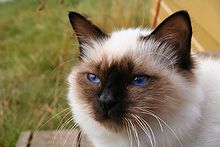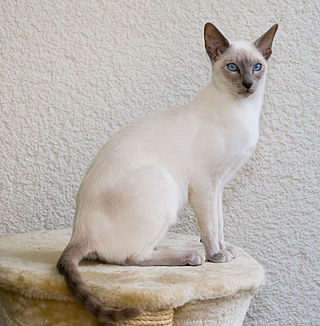
The Siamese cat is one of the first distinctly recognised breeds of Asian cat. Derived from the Wichianmat landrace, one of several varieties of cats native to Thailand, the original Siamese became one of the most popular breeds in Europe and North America in the 19th century. Siamese cats have a distinctive colourpoint coat, resulting from a temperature-sensitive type of albinism.

The York Chocolate is an uncommon American breed of show cat, with a long, fluffy coat and a tapered tail and most of them were mostly or entirely chocolate-brown or the dilute form of brown, known as lavender. The breed was named after New York state, where it was established in 1983. This breed was created by color-selecting domestic long-haired cats of mixed ancestry. The breed is not widely recognized by cat registries. It is not recognized by the major organizations such as The International Cat Association (TICA), the Cat Fanciers' Association or Fédération Internationale Féline.

The Sphynx cat also known as the Canadian Sphynx, is a breed of cat known for its lack of fur. Hairlessness in cats is a naturally occurring genetic mutation, and the Sphynx was developed through selective breeding of these animals, starting in the 1960s.

The Exotic Shorthair is a breed of cat developed as a short-haired version of the Persian. The Exotic is similar to the Persian in appearance with the exception of the short dense coat.

The Ocicat is an all-domestic breed of cat which resembles a wild cat but has no recent wild DNA in its gene pool. It is named for its resemblance to the ocelot. The breed was established from the Siamese and Abyssinian and later on American Shorthair would be added.

The Himalayan, is a breed or sub-breed of long-haired cat similar in type to the Persian, with the exception of its blue eyes and its point colouration, which were derived from crossing the Persian with the Siamese. Some registries may classify the Himalayan as a long-haired sub-breed of Siamese, or a colorpoint sub-breed of Persian. The World Cat Federation has merged them with the Colorpoint Shorthair and Javanese into a single breed, the Colorpoint.

The Somali cat is genetically similar to the Abyssinian cat. Due to inheriting 2 copies of the recessive gene for long hair, they have a characteristic luscious coat, unlike their cousin the Abyssinian.

The Burmese cat is a breed of domestic cat, originating in Burma, believed to have its roots near the Thai-Burma border and developed in the United States and Britain.

The Egyptian Mau is a small to medium-sized short-haired cat breed. They are one of the few naturally spotted breeds of domesticated cat. The spots of the Mau occur on only the tips of the hairs of its coat. It is considered a rare breed.
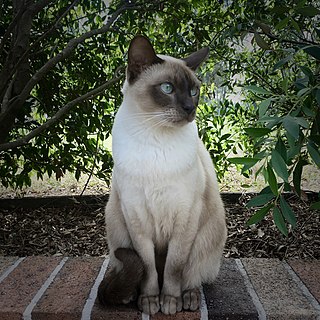
Tonkinese is a domestic cat breed produced by crossbreeding between the Siamese and Burmese. Members of the breed are distinguished by a pointed coat pattern in a variety of colors. In addition to the modified coat colors of the "mink" pattern, which is a dilution of the point color, the breed is now being shown in the foundation-like Siamese and Burmese colors: pointed with white and solid overall (sepia).

The Cat Fanciers' Association (CFA) was established in the United States in 1906. The CFA is currently the world's largest registry of pedigreed cats. Originally headquartered in Manasquan, New Jersey, the CFA moved to Alliance, Ohio in 2010. The association's stated mission is preserving and promoting pedigreed breeds of cats while also enhancing the well-being of all cats. CFA's first licensed cat shows were held in Buffalo, New York and Detroit, Michigan in 1906. The association today has a known presence in Europe, China, and Japan along with its well-established activity in the United States and Canada.

The Ragdoll is a breed of cat with a distinct colorpoint coat and blue eyes. Its morphology is large and weighty, and it has a semi-long and silky soft coat. American breeder Ann Baker developed Ragdolls in the 1960s. They are best known for their docile, placid temperament and affectionate nature. The name 'Ragdoll' is derived from the tendency of individuals from the original breeding stock to go limp and relaxed when picked up. The breed is particularly popular in both the United Kingdom and the United States.
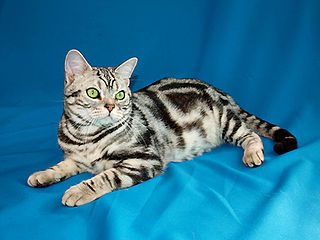
The American Shorthair (ASH) is a breed of domestic cat believed to be descended from European cats brought to North America by early settlers to protect valuable cargo from mice and rats. According to the Cat Fanciers' Association, it was the eighth most popular pedigreed cat in the world for 2020.

The Javanese, also known as the ColorpointLonghair in some registries, is a variety of purebred domestic cat.

The Singapura is the smallest breed of cat, noted for its large eyes and ears, ticked coat, and blunt tail. Reportedly established from three "drain cats" imported from Singapore in the 1970s, it was later revealed that the cats were originally sent to Singapore from the United States before being exported back to the US. Investigations by the Cat Fanciers' Association (CFA) concluded that no wrongdoing had occurred and the Singapura kept its status as a natural breed.

The Snowshoe is a rare breed of domestic cat originating in the United States of America in the 1960s. The Snowshoe is a short-haired bicolour colourpoint breed. Snowshoes were first produced when a Siamese breeder's cat gave birth to three kittens with white feet. The breeder, Dorothy Hinds-Daugherty, then began a breeding program to produce what were originally called "Silver Laces", crossing the strangely marked Siamese cats with bicolour American Shorthair cats and other breeds. Despite having existed for 45 years, Snowshoes are rare due to the difficulty of reproducing the correct coat markings.
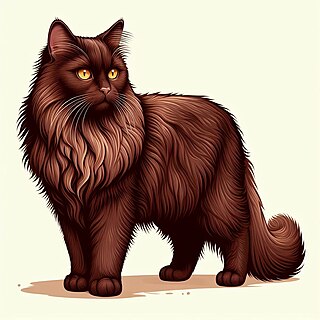
The Chantilly-Tiffany or Chantilly/Tiffany, also known as the Chantilly or the Foreign Longhair, was a breed of domestic cat which originated in the late-1960s in North America. The Chantilly breed never got off the ground and has always been rare. It was near-extinction in the late-1980s and again in the late-2000s. Since 2015 the breed was considered extinct with the passing and neutering of the last two cats of Chantilly lineage, and with no intact Chantilly cats the inevitable resulting discontinuation of the breeding program. However, new sightings of the Chantilly have been reported in the United States, disproving their extinction classification.

The Colorpoint Shorthair is a variety of Siamese cat. The only major registries to recognise them are the Cat Fanciers' Association (CFA) and the World Cat Federation (WCF). This breed was established from breeding American Shorthairs with the Siamese to produce different point colors, beyond the four standard Siamese colors.
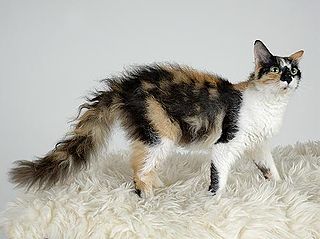
The LaPerm is a breed of cat. A LaPerm's fur is curly, with the tightest curls being on the throat and on the base of the ears. LaPerms come in many colors and patterns. LaPerms generally have a very affectionate personality.
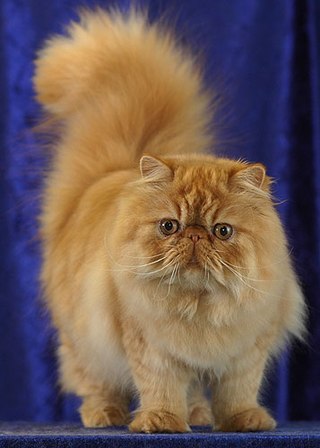
The Persian cat, also known as the Persian Longhair, is a long-haired breed of cat characterised by a round face and short muzzle. The first documented ancestors of Persian cats might have been imported into Italy from Khorasan as early as around 1620, however, this has not been proven. Instead, there is stronger evidence for a longhaired cat breed being exported from Afghanistan and Iran from the 19th century onwards. Widely recognised by the North-West European cat fancy since the 19th century, and after World War II by breeders from North America, Australia and New Zealand. Some cat fancier organisations' breed standards subsume the Himalayan and Exotic Shorthair as variants of this breed, while others generally treat them as separate breeds.
